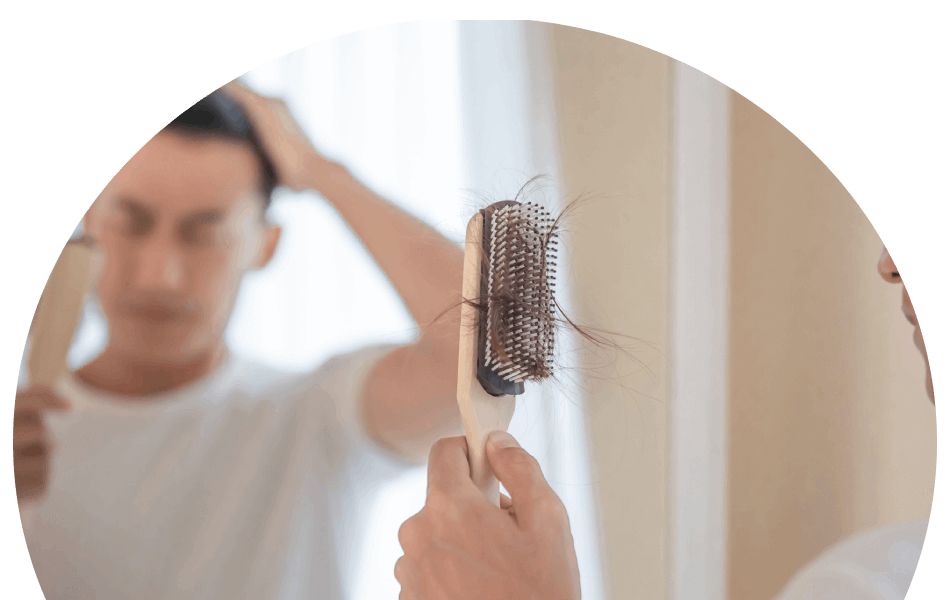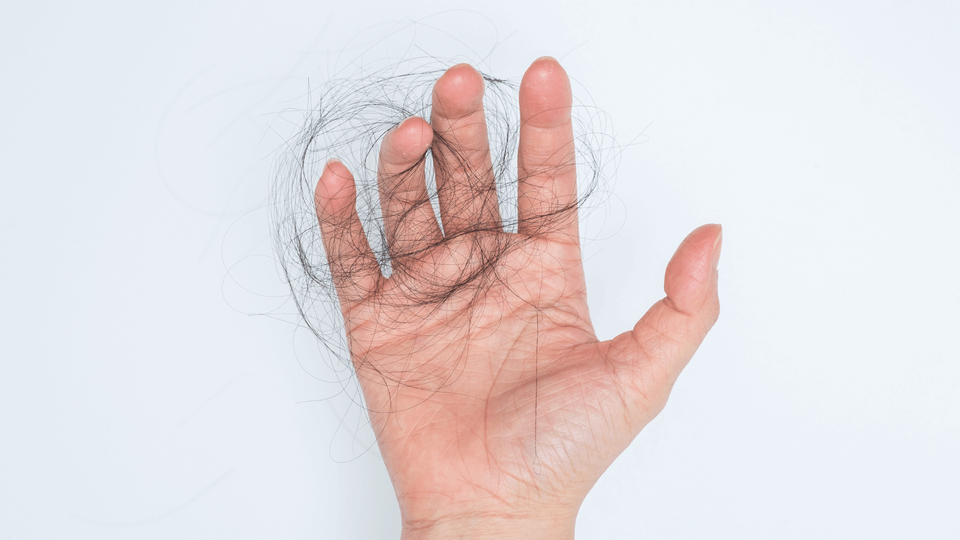Hair Thinning:
The Most Common Causes of Hair Loss


What Is Hair Loss?
Male pattern baldness (androgenic alopecia) is the most common type of hair loss in men. In fact, it affects approximately 30% of men by the age of 30 years old and 50% of men by the time they turn 50 years of age.
What Causes Hair Thinning?
Did you know that we typically lose 50 to 100 hairs each day? That might sound like a lot and you might be wondering “how have I never noticed that much hair falling out?”. This is because new hair is constantly growing at the same time, usually at the same rate as hair falls out. We start to notice hair thinning when new hair is not growing at the same rate as we are losing it.
There is no one cause of male hair loss, it can happen for many reasons – some causes can mean temporary hair loss and some can mean permanent hair loss. Let’s explore some of the most common causes.
Genetic
The most common type of male hair loss, androgenic alopecia, is genetic. It can be inherited from either parent. There is a popular belief that hair loss in men is passed down from the mother’s side of the family. However, this is a myth. The genes that cause hair loss can be passed down from both sides of the family.
Hormones
Hormones can play an important role in male hair loss. In androgenic alopecia, the hormone testosterone is converted to dihydrotestosterone (DHT), which causes hair follicles to shrink and hair to fall out. This process has more of an effect on some individuals than others and is usually more noticeable if you have a family history of male pattern hair loss.
Thyroid disorders, such as hypothyroidism (underactive) and hyperthyroidism (overactive), can also cause hair loss. In this instance, the hair will appear uniformly sparse and the entire scalp is usually affected. When the thyroid disorder is successfully treated, hair may grow back. However, it is worth noting that this may take several months and hair may not grow back as before.
Medical Conditions
Some medical conditions can also cause hair loss. For instance, alopecia areata causes patchy hair loss. Scalp infections can also contribute to hair loss but this is usually temporary – when the infection has been effectively treated, hair tends to grow back. Some of the most common infections that can cause hair loss include:
- Ringworm: a fungal infection that can develop anywhere on the body, but it develops on the scalp it can cause patches of hair loss, known as “tinea capitis”.
- Folloculitis: a term for inflammation of hair follicles, usually due to bacterial infection, which causes the hair to fall out.
- Piedra (trichomycosis nodularis): happens when the hair fibres are infected by a fungus. This causes hard nodules to form on the hair fibres, potentially weakening the hairs and causing them to break.
Skin conditions, such as eczema and psoriasis, may also contribute to hair loss, if it occurs on the scalp. While these skin conditions don’t cause hair loss directly, they can cause the skin to become inflamed and damaged. Thus, hair follicles can find it difficult to grow. Similarly, excessive itching may damage or break the hair.
Hair loss is also quite common if you have been very unwell from an infection such as COVID-19, pneumonia or flu. Once you recover, this usually starts to improve but can take 3-6 months to return to normal (1-2 hair cycles).

Medications
Hair loss can also be a side effect of certain medications and treatments. For instance, one might experience hair thinning as a side effect if you are taking medications to treat:
- Arthritis
- Depression
- Heart problems
- Gout
- High blood pressure
- Hormone-related conditions
Undergoing radiation therapy to the head, to treat head or neck cancer, can also cause hair loss.
Generally speaking, hair loss related to medications is reversible and hair will begin to grow back once you cease taking the medication – it just might take some time.
Stress
Prolonged, high levels of stress or an emotional or physical shock can also lead to hair loss. Usually, this type of hair loss is temporary and hair will grow back over time, once you have gotten your stress levels under control.
There are three types of hair loss that are commonly associated with high-stress levels:
- Telogen effluvium: significant stress pushes a large number of hair follicles into a “resting phase”. Within a couple of months, the affected hairs may start to fall out, causing the hair to thin.
- Trichotillomania: a disorder which causes an irresistible urge to pull out hair from the scalp, eyebrows or other areas of the body. For people with this disorder, hair pulling can be a way of dealing with negative or uncomfortable feelings, such as tension, stress, and frustration.
- Alopecia areata: this form of alopecia is related to the immune system. It is believed that severe stress can cause alopecia areata, amongst other factors. With this form of alopecia, the body’s immune system attacks the hair follicles, causing the hair to fall out.
Hairstyles and Treatments
How you style and treat your hair can also cause hair loss. For instance, pulling your hair tight can cause hair damage and breakage. Hairstyles, such as tight buns, cornrows and braids, can cause a type of hair loss known as traction alopecia.
There are certain hair treatments that can also lead to hair loss. Hot-oil treatments, when done incorrectly or excessively, can do more harm than good when it comes to hair regrowth. Rigorously massaging the head can cause friction between the hair strands and breakage and oil can clog the pores of the scalp follicles.
Likewise, the perming process can leave the hair extremely dry and brittle, making it more likely to break and fall out. Therefore, it’s important that you go to a professional hairstylist for your perms and treatments, to ensure the risk of damage is reduced.
Why Is My Hair Falling Out?
Whilst there are many potential causes for hair thinning and hair loss, how it develops can help you identify the cause. For example, androgenic alopecia or male pattern baldness develops gradually and follows a recognised pattern. You may notice:
- Gradual thinning of hair at the temples or crown of the head
- Receding hairline
- Loosening of hair and shedding more than before
Discrete circular bald spots can indicate alopecia areata. If the skin of the scalp also becomes scaly, red or irritated, in combination with patchy hair loss, you may have an infection, such as ringworm, or a skin condition, such as psoriasis or eczema.
If you notice any sudden or patchy hair loss or more hair falling out than usual, you should speak to a doctor as this can signal an underlying medical condition that requires treatment.

Can Hair Loss Be Prevented?
Yes, some types of hair loss are preventable by making some lifestyle changes and taking medications. Here are some tips to help avoid preventable types of hair loss:
- Be gentle with your hair! Avoid tugging when brushing by using a detangler when your hair is wet.
- Opt for a wide-toothed comb to avoid tugging or pulling the hair.
- Limit tension on hair by opting for looser hairstyles and use satin or silk hair ties to reduce friction on the hair.
- Avoid harsh treatments, such as perms and hot-oil treatments, where possible.
- Avoid excessive heat styling; curling irons, straighteners etc. can leave the hair dry and brittle.
- Protect your hair from sunlight and other sources of ultraviolet light.
- Stop smoking; some studies have shown an association between smoking and baldness in men.
- Ask your doctor about medications that can help stop hair loss (we’ll come back to this one in a moment!)
- If you’re being treated with chemotherapy, ask your doctor about a cooling cap. This cap can reduce your risk of losing hair during treatment.
Repeat Prescription
Hair Loss Treatment
While there is no cure for male pattern baldness, through our online service, you can request a prescription for Male Pattern Hair Loss Treatment. This treatment helps to prevent further hair loss and encourages new growth. Once your request has been approved, we can send your prescription directly to your chosen pharmacy via secure Healthmail.
Using Medications to Stop Hair Thinning
Whilst there is no cure for male pattern baldness, here at Webdoctor.ie, we can arrange a prescription for Oral Male Hair Loss Treatment for you! (Subject to clinical suitability) This medication can help prevent further loss and encourage hair growth.
This treatment blocks the conversion of the hormone testosterone to dihydrotestosterone (DHT). DHT causes male hair loss by causing the hair follicles to shrink and stop working. By decreasing DHT levels, hair loss is reduced.
It’s important to note, this medication will only stimulate hair growth on the scalp, it will not stimulate hair growth in other areas of the body. You should also note, this treatment is only prescribed for male (birth sex) patients via this service, as a treatment for male-pattern baldness – it is not suitable for treating other types of hair loss or females experiencing hair loss.
Requesting a prescription for Hair Loss Treatment couldn’t be easier with Webdoctor.ie! Simply fill in the short and secure questionnaire available via our online prescription service. Then, one of our Irish-registered doctors will review your request to ensure this treatment is medically suitable and safe for you. Once approved, we’ll send your prescription to an Irish pharmacy of your choice. Not only is this online prescription service super convenient and discreet…. It only costs €25! Check our Hair Loss Treatment page for more information.
Alternatively, if you have questions or concerns about this Hair Loss Treatment, please don’t hesitate to book an online video consultation with one of our GPs! There, we can answer any questions you may have.
How It Works
Through an online medical questionnaire, face-to-face video consultation or home health test, our online doctors will review your case and prescribe the best treatment for you.

Step 1
Online Questionnaire

Step 2
Medical Review

